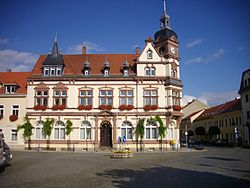Groitzsch
| Groitzsch | ||
|---|---|---|

Town hall
|
||
|
||
| Coordinates: 51°9′20″N 12°16′50″E / 51.15556°N 12.28056°ECoordinates: 51°9′20″N 12°16′50″E / 51.15556°N 12.28056°E | ||
| Country | Germany | |
| State | Saxony | |
| District | Leipzig | |
| Government | ||
| • Mayor | Maik Kunze (CDU) | |
| Area | ||
| • Total | 70.06 km2 (27.05 sq mi) | |
| Population (2015-12-31) | ||
| • Total | 7,626 | |
| • Density | 110/km2 (280/sq mi) | |
| Time zone | CET/CEST (UTC+1/+2) | |
| Postal codes | 04539 | |
| Dialling codes | 034296 | |
| Vehicle registration | L | |
| Website | www.groitzsch.de | |
Groitzsch (German pronunciation: [ˈɡʁɔʏtʃ]) is a town in the Leipzig district, in Saxony, Germany.
The town is situated at the southern edge of the Leipzig Bay east of the White Elster river on the confluence of Schwennigke and Schnauder rivers, 20 km northeast of Zeitz, and 25 km southwest of Leipzig. A transition to the Central German low mountain ranges is notable in several elevated places within the municipal boundaries.
Bundesstraße B176 passes through Groitzsch itself, and Bundesstraße 2 traverses the subdistricts Kobschütz and Audigast. The latter leads to a junction with new Bundesautobahn 38 about 15 km northeast of the town.
The nearest railway station is in Pegau on the Leipzig–Probstzella railway. Public transport is provided by buses of Mitteldeutscher Verkehrsverbund with direct services to Pegau, Zwenkau, Leipzig, Neukieritzsch, Böhlen, and Altenburg. The nearest international airport is Flughafen Leipzig/Halle.
The original Sorbian name was Groisca.
The oldest archaeological finds in the town district date from approximately 4000 BC. The area was comparatively densely populated in prehistoric times, and after the migration of Germanic tribes, Slavic peoples, referred to as Sorbs, migrated into the region after in the 7th century. Based on the continuity of pre-Slavic place names, it is likely that Thuringian settlements remained until the 8th or 9th century. During the Ostsiedlung of the early Middle Ages, the population mixed with settlers from Thuringia and Franconia. In the history of the town traces of Jewish life are also found.
...
Wikipedia




